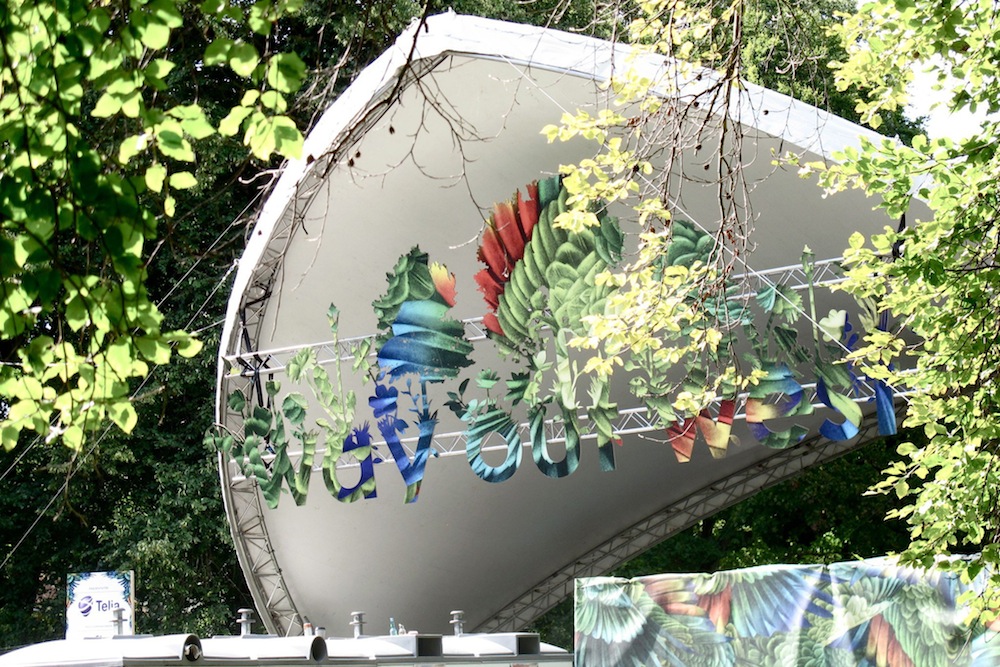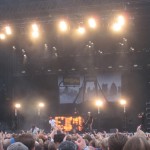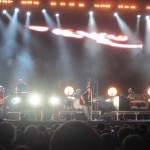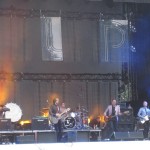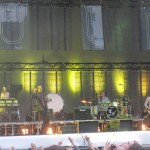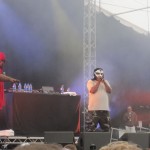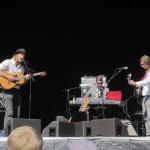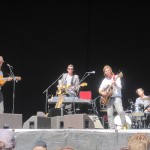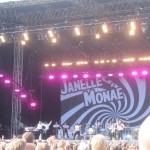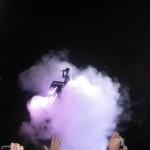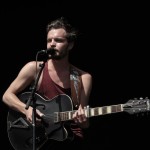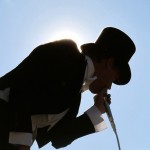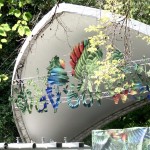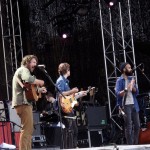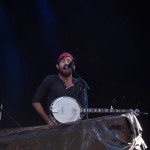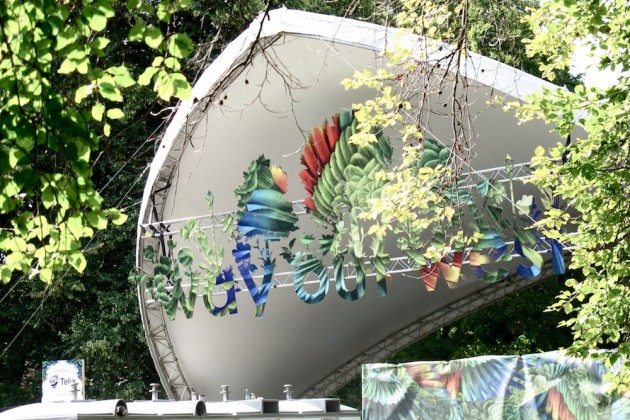
Photo by Amelia Bordahl
The Way Out West festival turned five this year, and yet again it took place in the beautiful Slottskogen Park in central Gothenburg, the second biggest city in Sweden following the capital Stockholm. This year Way Out West had certainly made an effort with headliners Prince and Kanye West, and other high-quality bookings such as Fleet Foxes, Pulp and Robyn to the festival stages. The festival area was open for two days, on Friday August 12 and on the following day, with three different stages, the main Flamingo stage, the slightly smaller Azalea and then a smaller tent stage called Linne. But the festival program is only half of Way Out West, with the Stay Out West club program containing even more artists scattered over clubs across Gothenburg.
The Stay Out West program is an excellent chance to see smaller acts in intimate venues, but since only a fraction of the 32,000 festival attendees will get in to the clubs you’re almost guaranteed to miss out on a bunch of great bands. The Stay Out West program opened on Thursday evening, with James Blake and Low at Annedalskyrkan and Okkervil River and Destroyer at Storan being the most popular gigs, and after trying and failing to get into the Okkevil River gig, I headed to Park Lane to see the unfamiliar bands Chad Valley and Hot Chip side-project About Group. Both delivered onstage and About Group especially impressed when they didn’t take the jam side of the band too seriously.
This year’s line-up at both the festival area and the Stay Out West program was impressive to say the least, with almost too many good bands being booked, making it almost impossible to find a chance to eat something, even being forced to use Robyn’s set for a break for food. Everything around the artists went relatively smoothly though, with the food being plenty if pricy and lines being kept to a minimum.
Friday
Christian Kjellvander
After missing out on Edward Sharpe & The Magnetic Zeros’ supposedly chaotic opening performance in the Linné tent, I began the day with Swedish folk singer-songwriter Christian Kjellvander who opened the Azalea stage with an excellent set. The Seattle-raised Kjellvander is highly respected in Sweden but is yet to find mainstream success, as made obvious by the relative disinterest among the audience, but during the one hour long set he definitely made a few new fans.
Kjellvander was among the last artists to be announced for the festival (only days before) and while it’s not surprising that he was given such an early stage time, his music would have been more at home in the dark. Musically, his work is reminiscent of the darker indie folk rock, of for example Jason Molina’s work in Songs:Ohia and Magnolia Electric Co., and performing in bright sunlight seemed unsuitable with the darkness of the music in mind. That said, Kjellvander and his band were excellent throughout the set and his unique voice worked very well in a live setting.
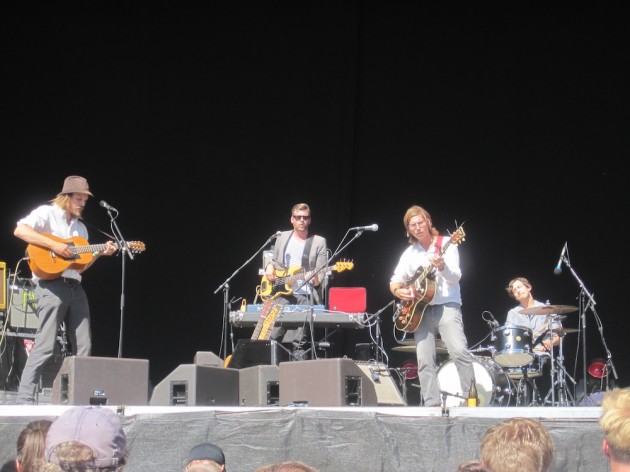
Photo by Johan Alm
The Avett Brothers
I’ve had a weird relationship with The Avett Brothers prior to the festival, first listening to I And Love And You in 2009 without becoming a fan and then listening to last year’s Live, Volume 3 prior to the festival and enjoying it a lot. Due to the strength of Live, Volume 3, I was excited about seeing the band live, and their opening number didn’t disappoint – but after that it quickly went downhill for me as the gig became more of a showcase of how excited the band could look on stage than about the actual music.
To be fair, as I’m not a fan of the band or particularly knowledgeable where their discography is concerned, I’m not really someone who should be judging them, and the majority of everyone in attendance seemed to be enjoying their performance a lot. Despite playing as early as three in the afternoon, the band had drawn a large audience who responded enthusiastically to the gig, in a similar way as how Mumford & Sons drew an even larger audience to their afternoon slot at last year’s festival, and whatever my own complaints may be it’s hard to deny The Avett Brothers’ skills as live performers.
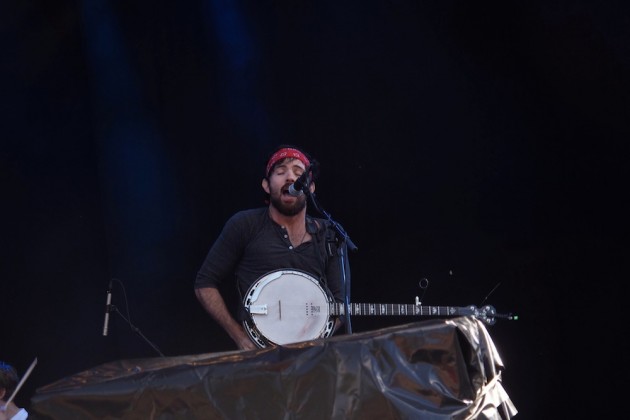
Photo by Amelia Bordahl
Janelle Monáe
When Janelle Monáe released her full-length debut The ArchAndroid last year, she surprised many, including yours truly, with her charisma and skill, managing to combine more genres than should be possible on the album (and receiving a 89% rating and a recommended tag here at One Thirty BPM). The ArchAndroid and her live show brought her a lot of attention, not the least from admirers such as Prince, but here in Sweden she is yet to make it big, although she still drew a large enough audience to the Azalea stage.
Everyone in attendance was treated with a show that was fun, interesting, and kept you’re attention despite being all over the place – but above all it showed that Janelle Monáe has the charisma necessary to be playing the really big stages. What really made the show a memorable one was how tight the band was, coupled with Monáe’s stage presence and the excellent three closing songs; a cover of the Jackson 5 classic “I Want You Back” and Monaé’s own “Cold War” and “Tightrope.”
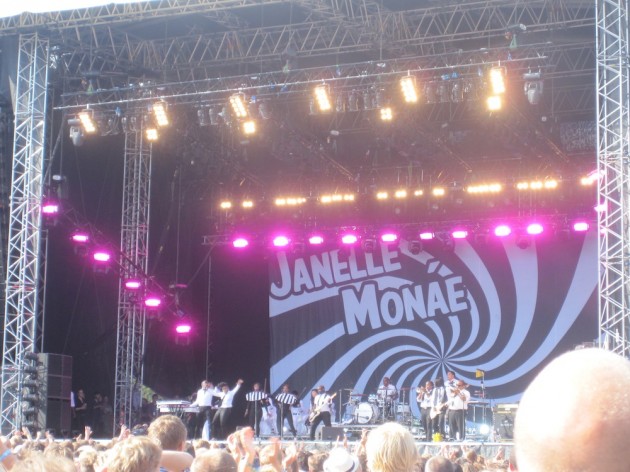
Photo by Johan Alm
The Hives
It’s been four years since The Hives released their latest record, The Black And White Album, and while they’ve been touring quite often since they’ve been remarkably quiet otherwise. The Hives’ Way Out West performance is their only Swedish gig this year, but when they entered the stage in their matching black-and-white outfits it might as well have been 2007 again, except for the fact that most of the gig was devoted to pre-The Black And White Album material.
The Hives are above all entertainers, and while there are lots of things to criticize about them, they’ve got the somewhat rare ability to turn quite angular rock songs into danceable anthems during their gigs, something they had no trouble doing at Way Out West. While there is no question that their stage show and Howlin’ Pelle Almqvist’s charisma as a frontman are a force to be reckoned with, they won’t surprise you — it’s predictable but very well-performed. In short, The Hives are the best band in the world at being The Hives, but over the course of an entire gig it gets a bit too predictable and unsurprising, especially when most of the set consists of older material and the two new songs lacked the punch of their classic tracks.

Photo by Amelia Bordahl
Fleet Foxes
Besides the headliners Prince and Kanye West, Fleet Foxes were among the highest advertised acts before Way Out West and they delivered a show worthy of a festival headliner. While many of the acts during the festival were, to put it mildly, big ego showcases, Fleet Foxes had a decidedly minimalistic and scaled back set in comparison, instead letting the music shine. Fleet Foxes became the indie darlings of the world with the release of their self-titled debut LP and Sun Giant EP in 2008, but this year’s Helplessness Blues certainly showed a marked growth in the band and helped cement them among the very best in indie-folk. This maturity and confidence was easily visible during the set, which consisted of songs taken from all three releases, with the 2008 songs all being markedly stronger than their album counterparts.
The main difference between Fleet Foxes live and in studio is that while their studio work is clearly the work of perfectionists the live shows are looser and rawer, adding a sense of personality and closeness that at times might get lost on record. All in all the band were in great form, and the performance would have been the highlight of a regular festival day, but most days don’t have Prince as the headliner.
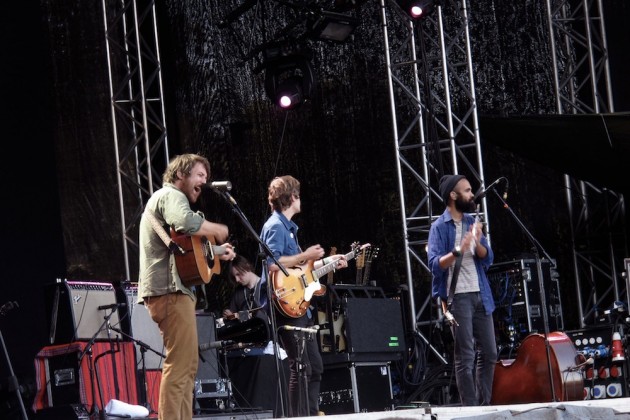
Photo by Amelia Bordahl
Thåström
Swedish singer-songwriter Joakim Thåström is almost a living legend within alternative music in Sweden, starting out with, what is without a doubt the biggest and most successful Swedish punk rock band, Ebba Grön during the first wave of punk rock in the late ‘70s and early ‘80s. Thåström and Ebba Grön was known for their left-wing politics and after the demise of Ebba Grön Thåström and two of the other band members formed the more post-punk leaning Imperiet, and since the break-up of Imperiet in 1988 Thåström has become a very respected singer-songwriter and live act in his own right.
Thåström’s performance at Way Out West was his only gig during 2011, and it was obvious that the now 54 year-old Thåström and his band wanted to make it one to remember. Musically an easy reference point for non-Swedes would be Nick Cave and the Bad Seeds, with a more rough-voiced vocalist but an equal darkness, albeit focusing on different issues at times. Live, it translates exceedingly well with Thåström being as charismatic a frontman as you can hope for despite keeping the audience interaction minimal, and add to that the strength of his songs it’s without a doubt a success. Due to Prince going on right after Thåström, I had to leave early in order to get a good view, something I regretted while leaving, and came to regret even more when Thåström and band launched into Ebba Grön’s punk classic “Die Mauer” at the end of the set.
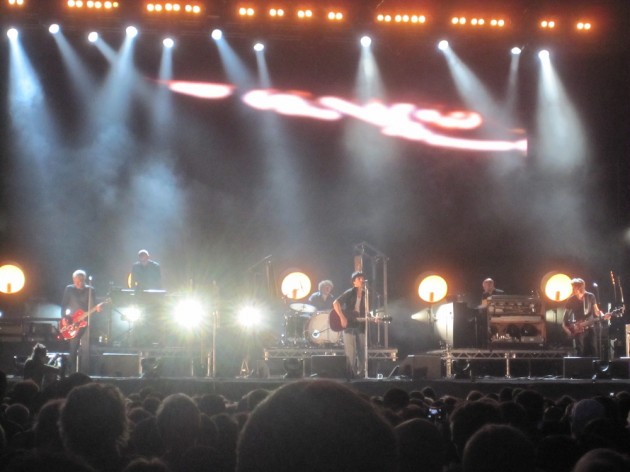
Photo by Johan Alm
Prince
Kanye West may be the biggest artist in the world right now, but Prince might just be a bigger booking for the festival, and he’s certainly one of the most important artists out there still doing live gigs. More importantly though he hasn’t lost his touch and, while his latter day recordings aren’t close to his strongest, his live show counts him among the very very best. During the gig at Way Out West he showed why he is still considered among the greatest artists of our time – or the “greatest living performer” as Kanye West called him during his closing set on Saturday.
Prince may be over 50 years old but when he is onstage he may as well be twenty-five, showing more agility and more impressive dance moves than performers half his age would be capable of, while not missing a note vocally. The gig was in many ways a showcase of Prince’s skills in the songwriting department with a setlist that doesn’t even need to be recited – you all know the songs, the hits, and the classics, and fortunately he showed the grace to avoid including much of his not-so-great latter day work. What may not be as sure as the quality of his work is the fact that his voice has aged extremely well in the sense that he still has the same vocal abilities that he had when writing and recording said songs over 20 years ago.
One of the highlights of the evening was the performance of the classic “Purple Rain,” after which many left the audience, thinking that Prince was surely finished, but those who did so missed out on another hour of excellence, playing long after the gig was supposed to have ended. Throughout the gig Prince showcased his impressive vocal strength, but also showed once again why he should be considered among the greatest guitarists alive – a skill he’s often uncredited with among rock journalists due him being a “pop artist.”
Everyone in attendance should agree that what was witnessed was simply the kind of concert most casual concert-goers won’t ever experience, and when Kanye West came onstage acting as Prince’s hypeman for a short while (leaving again before large parts of the audience had time to realize who he was) it only cemented the gig as one that will be remembered for years.
Saturday
The Tallest Man On Earth
As with Christian Kjellvander on the previous day, The Tallest Man On Earth held the two o’clock spot at the Azalea stage, being booked only days in advance – during the set he mentioned receiving the call while fishing less than a week earlier. Full disclosure: I’m a big fan of The Tallest Man On Earth and this was the sixth time seeing him live, and he has certainly come a long way from the first time I saw him live – playing in front of 60-ish people in the summer of 2009.
With a minimal stage set-up – only four guitars, a mic and a piano, the not-so-tall Kristian Matsson from Dalarna, Sweden managed to command the huge stage very well and delivered a set that held up to his usual extremely high standard. It was noticeable that he was not really used to being onstage though, with a couple of forgotten lyrics and the like, but he managed to turned the mistakes into something positive – and the audience was willing enough to forgive him.
The set contained no surprises, with tracks taken from his debut LP Shallow Grave, last year’s breakthrough album The Wild Hunt and its follow-up EP Sometimes The Blues Is Just A Passing Bird. The highlight of the set was unsurprisingly “Love Is All,” and also “Thrown Right At Me,” which he as usual performed with Idiot Wind at the end of the set, a beautiful love song made all the more poignant by the couple performing it.
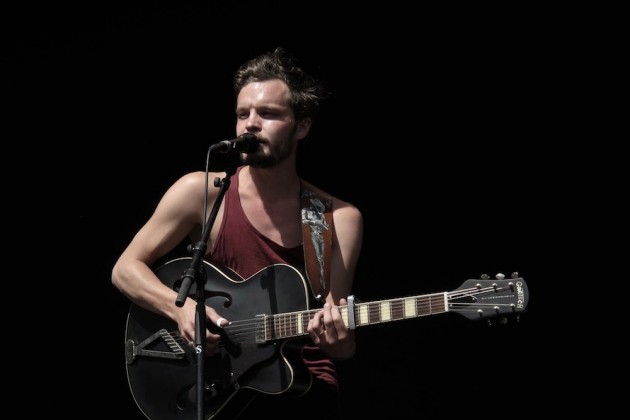
Photo by Amelia Bordahl
MF Doom
Cult hip-hopper MF Doom was one of the last bookings to Way Out West, being confirmed only days before the festival to replace hip-hop legend Q-Tip who cancelled for the second year in the row. Q-Tip’s cancellation meant that Wiz Khalifa was moved to the larger Azalea stage and MF Doom took Khalifa’s slot in the Linne tent, and personally I found it to be a very interesting booking – as long as he wouldn’t bring his impostor.
The actual gig was very much a disappointment, though, but not really due to MF Doom or his hypeman, but rather the terrible sound which made all the lyrics blend together and even made the beats all but indistinguishable from each other. With a stage show such as the one Kanye West delivered later this evening, it might have been alright, but with a minimal stage show like Doom’s, the lack of both lyrics and beats made it less than interesting.
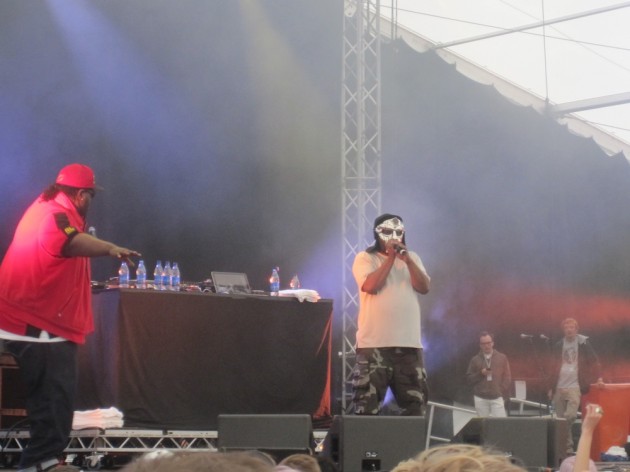
Photo by Johan Alm
Jamie Woon
After MF Doom the choice was between Swedish pop act Säkert! and British dubstep-pop hype Jamie Woon, and while I’m not as big a fan of Woon’s Mirrorwriting as some, I’ve never cared for Säkert! at all. Woon has been marketed as musically similar to James Blake, but in truth Woon lacks Blake’s more adventurous compositions and focuses instead on a smoother soul-inspired dubstep-pop.
In a live setting much of the soul-inspiration apparent on Mirrorwriting is lost, and while Woon and his band aren’t exactly the most memorable when it comes to stage presence, they performed solidly but unspectacularly, making every fan in the audience happy, but perhaps not winning many new ones. The gig was in short a very accomplished one, but it didn’t leave as big an impression as it could have been due to relative lack of anything standing out.

Photo by Johan Alm
Wiz Khalifa
Wiz Khalifa was moved from the small Linne tent to the much larger Azalea stage after Q-Tip’s cancellation and I had my reservations after being less than impressed by his studio work, believing many of his contemporaries far more worthy of the attention he’s given. Wiz Khalifa surprised me though, showing a lot of enthusiasm and a good command of a stage this large, making his relatively unremarkable songs sounding far better and more captivating live than on record.
The most lasting impression of Khalifa’s show was the energy and joy he projected during it, and how he worked the stage together with his hypeman, without missing lines in the way many other rappers would do while keeping that tempo. Yet the lack of substantial tunes to support the stage act, and the lack of a live band to give the existing songs an extra punch live, kept the gig from becoming more than it was – but for what it was it was really good; fun and entertaining hip-hop for the casual listener.

Photo by Johan Alm
Pulp
It has been remarkably quiet about the Pulp reunion in Sweden prior to the Way Out West festival, with all the focus being on Kanye West, Prince, Fleet Foxes and even James Blake rather than on Pulp – while the rest of the world has been going crazy for the reunion. A reunion with a band of this standard should always be treated with care, but Jarvis Cocker and the rest of the band has been receiving stellar reviews during their earlier gigs and at Way Out West they certainly lived up to these.
I’m the first to admit that I’m far from a Pulp expert, being far more knowledgeable about pretty much every one of the other big Britpop bands, but after seeing the band live I’m more than ready to remedy this. The first thing that you noticed during the show was how remarkably tight the band is, with close to everything being perfect – even aborting and restarting a song when it didn’t feel right, and of course Jarvis Cocker’s impressive charisma as a frontman. With a tight band, a charming and entertaining frontman, and a setlist of almost nothing but hits it would have been hard for Pulp to have been anything but impressive and when they ended with the classic “Common People,” they had definitely succeeded in showing the Swedish audience that there should’ve been more buzz about the reunion beforehand.
Kanye West
Kanye West is arguably the biggest pop artist in the world right now, and it would be fair to say that a many of the festival attendees were only there for him, and possibly Wiz Khalifa, making him in some way even more of an attraction than Prince. After a bit of a wait, and the operating H.A.M. intro, Kanye entered the stage on a lift and performed “Dark Fantasy” from several meters above the excited audience.
There was no question that this was one of the biggest artists in the world, a man with a gigantic ego backed by nearly unlimited funds, when he was supported by around fifteen dancers, a few musicians, a backdrop depicting ancient sculptures, more than a few lasers and had the show separated into three acts. Kanye’s ego and insecurities are often criticized and the man himself is often demonized in the press (at times for good reason), but to use this as a complaint of the live show as many reviewers has is missing the point. Without Kanye’s ego, insecurity and megalomania his music and persona wouldn’t be nearly as captivating and interesting, as evident on last year’s close-to-masterpiece My Beautiful Dark Twisted Fantasy, where the flaws are as interesting as the successes.
While Kanye West has been releasing music for less than ten years he still has enough great tracks to fill a 20+ setlist with nearly only tracks that could be counted among the very best of the new millennia, and the audience responded in kind. Hit after hit was performed to the audience’s delight, and with tracks like “All Falls Down,” “Through the Wire,” “All of the Lights,” and “Power” being only a few of many Kanye showed why he deserves the big stages, proving to be a captivating live performer as well as a great producer and studio artist.
The more interesting parts of the show, and the more criticized, were the more personal moments where he would rant in true Axl Rose-style about a world and an industry that didn’t understand him and was trying to bring him down. While it’s easy to claim that Kanye West is one of the biggest stars in the world and should be happy with his lot that is very much taking the easy way out, because while it may be true it is hardly the point – the point is that Kanye really feels this way and that I what makes his music as powerful as it is. Because Kanye truly believes what he says and he says it with such a conviction that his auto-tuned therapy sessions in front of a live audience become just as interesting, if not more, than the actual songs.
One of these highlights were the performance of the epic “Runaway,” on which Pusha T came onstage to perform his verse, and ended with an auto-tuned freestyle about Kanye’s many faults, insecurities, and how he is “an asshole.” When Kanye ends the third act of a show that could only have been put on by Kanye West, he doesn’t end it with one of his biggest hits, but with the deeply personal “Hey, Mama” – a fitting end for what might be the most divisive, hated and loved, musician right now.
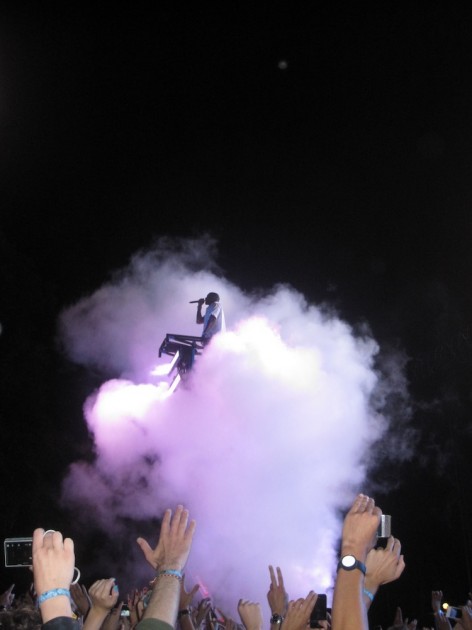
Photo by Johan Alm

